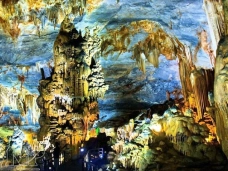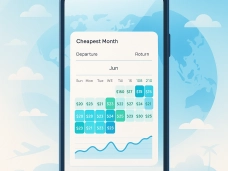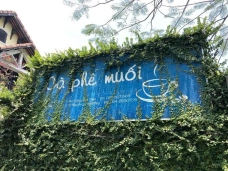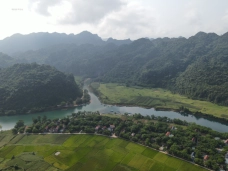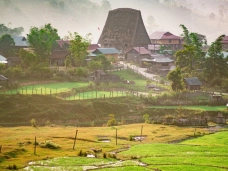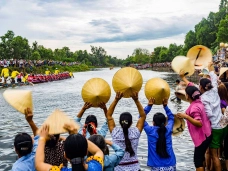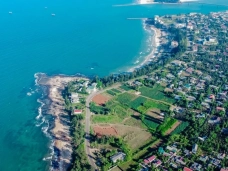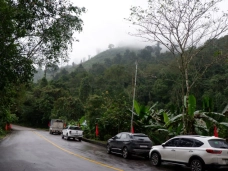Across Hien Luong Bridge – Two Sides, One Soul
30-04-2025 23:00
Ben Hai River – A Silent Witness of a Divided Land
April. The sunlight spills endlessly over Central Vietnam, warm enough to stir memories once buried under fire and steel.
I stand by the banks of the Ben Hai River—a place that once marked a merciless boundary, dividing the country for 21 long years.
Here, even the river’s gentle current seems to echo the past—gunfire, weeping, and an aching yearning for reunion.
The Ben Hai flows peacefully now, as if it had never known the agony of war.
But if you stand still for just a moment, you’ll feel it: every patch of earth, every breath of wind here holds the sediment of untold memories—layered and sacred.
In 1954, after the Geneva Accords, the Ben Hai River abruptly became a temporary military demarcation line, splitting Vietnam at the 17th parallel.
It turned into a raw, open wound—a line that severed not just land, but families.
People stood on opposite banks, calling out to loved ones across the water, powerless to reach them.
 Ben Hai River – Hien Luong Bridge During Vietnam’s Separation. Image courtesy of archives
Ben Hai River – Hien Luong Bridge During Vietnam’s Separation. Image courtesy of archives
The Geneva Accords: A Temporary Line That Became a Historic Scar
It can be said that the Geneva Accords turned a provisional divide into a lasting wound in Vietnam’s history.
Signed on July 20, 1954, following the victory at Dien Bien Phu, the accords marked the end of the First Indochina War between France and the Viet Minh. Amid Cold War tensions, the great powers—the United States, Soviet Union, China, Britain, and France—alongside representatives from Indochina, reached a fragile agreement: to cease hostilities and temporarily divide Vietnam at the 17th parallel, pending a general election in two years to reunify the country.
Yet the agreement was an imperfect promise. It lacked an effective enforcement mechanism, wasn’t signed by all parties (notably the U.S.), and was hastily drafted in under three months. It reflected a political compromise among superpowers more than a victory for justice.
On the ground, the 17th parallel and Ben Hai River became a painful symbol of division. What was meant to be temporary turned into a 21-year-long fracture. Provisions like the 1956 nationwide election were never fulfilled. In their place came ideological confrontation, family separation, and years of bloodshed.
In the South, the U.S. backed the Ngo Dinh Diem regime, rejecting unification talks and laying the foundation for the Republic of Vietnam. In the North, the Democratic Republic of Vietnam prepared for a renewed resistance as the accords unraveled.
Thus began one of Vietnam’s most devastating chapters: the Vietnam War—a two-decade-long conflict that plunged the nation into a new spiral of sacrifice, sorrow, and fire.
Ultimately, the Geneva Accords represented a missed opportunity for peace. They ended one war only to open the door to another—fiercer, broader, and more consequential. Geopolitical maneuvering by global powers prioritized strategic interests over the Vietnamese people’s right to self-determination. Vietnam became a bargaining chip in a global chess game.
The lesson of Geneva is one of the fragility of peace when it lacks fairness and goodwill. It is a reminder of the high cost a nation pays when its fate is decided by foreign hands.
And above all, it teaches us this: no peace lasts forever unless it is guarded by courage, self-reliance, and the unified will of those whose blood runs through the land.
 On the Other Side of the Divide. Photo: Archival Material
On the Other Side of the Divide. Photo: Archival Material
Một cây cầu, một vạch sơn – hai nửa đất nước
Trên cầu Hiền Lương, dài 178 mét, ngay chính giữa người ta sơn một vạch trắng rộng đúng 1 cm – chỉ vỏn vẹn một phân. Nhưng nó đủ để phân chia không gian, số phận và cả tương lai của hàng triệu con người. Một phân ấy, đã khiến biết bao người mẹ không được nhìn mặt con, bao người vợ ôm khăn góa bụa, và bao đứa trẻ lớn lên trong câu hỏi "Cha con là ai, ở đâu?".
Tôi dạo bước trên cây cầu ấy, tay lướt nhẹ qua lan can cũ kỹ như đang chạm vào chính những mảnh ký ức đau thương. Những câu chuyện tưởng như chỉ có trong tiểu thuyết chiến tranh lại từng diễn ra nơi đây, khốc liệt nhưng đầy bi tráng.

One Bridge, One Painted Line – Two Halves of a Nation. Photo: Archival Material
A Bridge, A Painted Line – And a Nation Divided in Two
On the Hien Luong Bridge, just 178 meters long, a white line—only 1 centimeter wide—was painted right down the middle. Just one centimeter.
Yet it was enough to divide not only space, but also fate, and the future of millions of lives.
That single line kept mothers from seeing their children, left countless wives widowed, and raised generations of children wondering, “Who is my father, and where is he?”
I walked across that bridge, my hand brushing the rusted railing—as if touching the fragments of a nation’s sorrow.
Stories that seem born of war novels were once lived right here: tragic, but deeply human.
Wars Without Bullets Across the Divide
Hien Luong was once the stage for one of the most surreal “psychological wars” in modern history.
From 1956 to 1967, both sides competed—not in gunfire, but in the height of flagpoles.
The northern side raised a flagpole as tall as 38.6 meters, with a flag covering 134 square meters—a bold statement that even in division, the will for unity never faltered.
Then came the “war of paint.”
Each side repainted its half of the bridge in contrasting colors—over and over again. The North eventually painted the whole bridge a single color, symbolizing the dream of reunification.
For nearly five years, this bridge became an unwilling canvas in a war no one wanted to paint, yet everyone was compelled to continue.
And finally, the war of loudspeakers.
From 1954 to 1965, propaganda and songs blared across the river from both sides—hours upon hours each day.
Standing before the old loudspeakers on display today, I could almost still hear the echoes—voices calling out for peace, for reunion, for home.
The Longing for Unity – The Day the Nation Reunited
Beside Hien Luong stands a statue titled “The Aspiration for Reunification”—a mother holding her child, her gaze fixed northward, eyes deep with eternal waiting.
I stood silent before that gaze—the gaze of so many Vietnamese mothers, whose quiet endurance made them eternal.
And suddenly, I remembered the verse:
“Only a river apart, yet love aches and longing burns.
One bridge shared, but destiny remains divided.”

The Nation Reunified. Photo: Archival Material
And then came April 30, 1975—the day the red flag with a yellow star flew high above the Hien Luong flagpole.
On that day, all separation was erased. Ben Hai River was no longer a demarcation line. Hien Luong Bridge was no longer a border. The two banks were rejoined—not merely with concrete and steel, but with blood and sacrifice, tears, and the eternal will of a people who never bowed their heads.
As I stepped down from that historic bridge, I knew I had walked across more than just a landmark— I had crossed into a living chapter of history. A chapter written in blood, in the yearning for peace, and in the hearts of millions of Vietnamese who love their homeland.
Hien Luong.
Comments
Comments (Total 1)
Hoàng Long
27-05-2025
Related Articles
26-11-2025
Khe Sanh – A Journey into Memory
05-11-2025
8 Unmissable Instagram Spots in Da Lat
28-10-2025
Beneath the Arch of Scarlet Blossoms
31-07-2025



